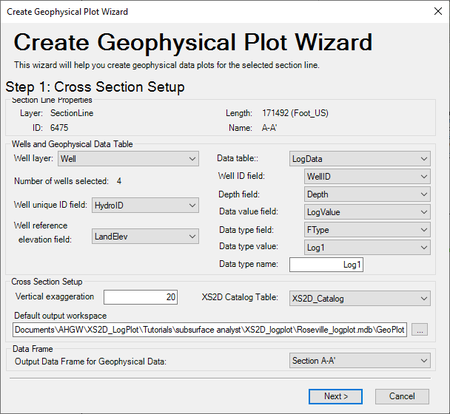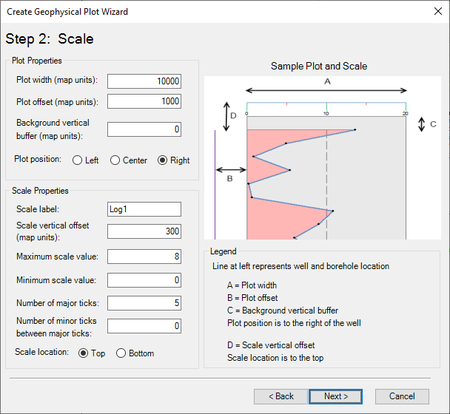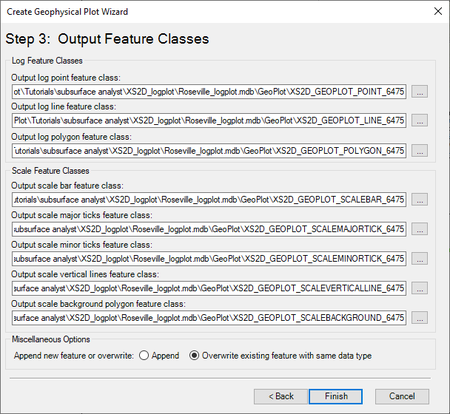AHGW:Create Geophysical Plot Wizard
The Create Geophysical Plot Wizard dialog is accessed by clicking either ![]() Import XS2D Image Wizard or
Import XS2D Image Wizard or ![]() Create Geophysical Plot Wizard for Wells (depending on what options are desired) on the Arc Hydro Groundwater Toolbar. This tool helps create geophysical data plots for the selected section lines or wells in ArcGIS.
Create Geophysical Plot Wizard for Wells (depending on what options are desired) on the Arc Hydro Groundwater Toolbar. This tool helps create geophysical data plots for the selected section lines or wells in ArcGIS.
Cross Sections
When ![]() Import XS2D Image Wizard is clicked, the wizard contains the following steps:
Import XS2D Image Wizard is clicked, the wizard contains the following steps:
- Step 1: Cross Section Setup
- Step 2: Scale
- Step 3: Output Feature Classes
Cross Section Setup
The following sections, options, and fields are available:
- Section Line Properties section – Not user editable in this dialog. Displays the following properties
- Layer – The name of the layer.
- ID – The section line ID.
- Length – The length of the selected section line.
- Name – The name of the selected section line.
- Wells and Geophysical Data Table section
- Well Layer – Select the desired well layer from the drop-down.
- Number of wells selected – The number of wells currently selected.
- Well unique ID field – Select from the drop-down the unique ID field to use.
- Well reference elevation field – Select from the drop-down the well reference elevation field to use.
- Data table – Select the data table from the drop-down.
- Well ID field – Select the well ID field from the drop-down.
- Depth field – Select the depth field from the drop-down.
- Depth value field – Select the depth value field from the drop-down.
- Depth type field – Optional. Select the data fype field from the drop-down.
- Data type value – Required if Data type field ise set. Select an additional data type field from the drop-down.
- Data type name – Required if Data type field and Data type value are set. Enter a name for the data type.
- Cross Section Setup section
- Vertical exaggeration – Enter a decimal value for the vertical exaggeration.
- XS2D Catalog Table – Select the XS2D catalog from the drop-down.
- Default output workspace – Displays the absolute path to a default output workspace. Click
 to bring up the Select Output Workspace dialog where a workspace can be designated.
to bring up the Select Output Workspace dialog where a workspace can be designated.
- Data Frame section
- Output Data Frame for Geophysical Data – Select the output data frame from the drop-down. In addition to "<Create new data frame>", other available data frames will be listed in the drop-down.
Scale
This step defines the plot and scale properties.
Plot Properties
- Plot width
- Plot offset
- Background vertical buffer
- Plot position
Scale Properties
- Scale label
- Scale vertical offset
- Maximum scale value
- Minimum scale value
- Number of major ticks
- Number of minor ticks between major ticks
- Scale location
Sample Plot and Scale
Output Feature Classes
This step defines the output feature classes.
Log Feature Classes
- Output log point feature class
- Output log line feature class
- Output log polygon feature class
Scale Feature Classes
- Output scale bar ticks feature class
- Output scale major ticks feature class
- Output scale minor ticks feature class
- Output scale vertical lines feature class
- Output scale background polygon feature class
Miscellaneous Options
- Append new feature or overwrite
- Append
- Overwrite existing feature with same data type
Wells
When ![]() Create Geophysical Plot Wizard for Wells is clicked, the wizard contains the following steps:
Create Geophysical Plot Wizard for Wells is clicked, the wizard contains the following steps:
- Step 1: Geophysical Plot Setup
Note: A well layer that follows the Arc Hydro Groundwater Schema must exist on the map prior to using this tool. A warning to this effect will appear if such a layer does not exist.
Geophysical Plot Setup
The following sections, options, and fields are available:
- Selected Well Properties section – Displays the Layer name and ID on the left. The following drop-down is on the right:
- Well reference elevation field – Select the desired field from the drop-down. The default selection is "LandElev".
- Geophysical Data Table section
- Data table – Select the desired data table from the drop-down. The default is "XS2D_Catalog".
- Well ID field – Select the field containing the Well ID.
- Depth field – Select the field containing depth data.
- Filtering field – Optional. Select a field to use for filtering the data. Default is "<not used>".
- Filtering value – Optional. Select a value to use for filtering the data. Default is "<not used>".
- BoreholeLog Table section
- BoreholeLog table – Select the desired table from the drop-down.
- Well ID field – Select the desired field from the drop-down. Options change based on available fields in the selected table (above option).
- Input Options section
- Use Depth Range – Turn on to enter a specific range to use.
- Min – Available if Use Depth Range is turned on. Enter a decimal minimum value for the range.
- Max – Available if Use Depth Range is turned on. Enter a decimal maximum value for the range.
- Read – Select from the following options:
- "Every row of data"
- "Every other row of data"
- "Every 3rd row of data"
- "Every 4th row of data"
- "Every 5th row of data"
- "Every 6th row of data"
- "Every 7th row of data"
- "Every 8th row of data"
- "Every 9th row of data"
- "Every 10th row of data"
- "Every 11th row of data"
- "Every 12th row of data"
- "Every 13th row of data"
- "Every 14th row of data"
- "Every 15th row of data"
- "Every 16th row of data"
- "Every 17th row of data"
- "Every 18th row of data"
- "Every 19th row of data"
- "Every 20th row of data"
- Plot Setup section
- Vertical exaggeration –
- XS2D Catalog Table –
- Default output workspace –
- Data Frame section
- Output Data Frame for Geophysical Data – Select the output data frame from the drop-down. In addition to "<Create new data frame>", other available data frames will be listed in the drop-down.



